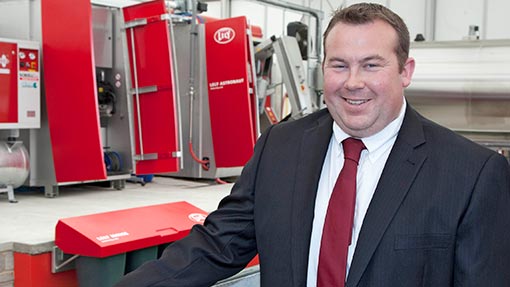Livestock Event 2014: Robotic feeder increases milk from forage by 1,000 litres

Robots dominated last week’s Livestock Event, including the world’s first combined demonstration of a herd being milked and fed. Richard Allison looks at the combined benefits.
Ditching the feeder wagon and abandoning the parlour to let cows decide when to be milked and fed results in healthier cows that produce more milk from forage.
Robotic milkers have been around for years, but robot feeders are much more recent, with only a handful on UK farms and two new systems making their debut at the event.
Combining both brings even more benefits, said independent consultant and North Yorkshire farmer Tim Gibson.
See also Video: Lely demos robotic milking range
He has many years experience with robots both as a farmer and consultant, with the first milker being installed on his farm in 2005. And his 200-cow herd has been fed with a robot for nearly two years, using his own system.
Milk from forage
“Since switching to robotic feeding, dry matter intakes have increased, resulting in more milk from forage. In the first year, we saw a 1,000-litre-a-cow increase in milk from forage, making better use of forage.
He said this increase is down to feeding more regularly, every two hours, resulting in more consistent rumen fill and better cow health.
There was also less waste with cows fed on a just-in-time basis. “A sensor measures the strain in the trough and the system knows when it is running out and needs to feed more.”
Longer term, the herd average rose over the past two years from 8,000 to 10,000 litres.
“Previously, we didn’t have a feeder wagon and were block feeding silage. It has allowed us to use a wider range of feed ingredients such as brewers grains.
Combined with milking little but more often, the yield from forage had risen and Mr Gibson was feeding less concentrate. “We have cut concentrate use by about 1kg/cow a day overall, resulting in a higher margin over feed.”
Cow stress
There was much less cow stress by feeding and milking more regularly, said Mr Gibson. “Not every cow gets up to feed every two hours.
“More timid cows will go to be milked when the more dominant cows feed and in turn will feed when the dominant cows are being milked. More regular feeding and milking spreads activity in the building, therefore helping more timid cows.”
Labour savings were considerable. Feeding Mr Gibson’s 200 cows took just 20 minutes and only involved replenishing the bunkers with forage and concentrates.
“That is all we need to do and the system automatically feeds about every two hours,” he said.
Building efficiency
One perception with robotics is the high capital cost, but as Mr Gibson highlighted, it allows a more efficient use of buildings, cutting capital needed for housing.
“Using a feeder wagon and tractor means you need a bigger building and it’s the same with parlours, with the robot taking up much less space. In addition, about one-third fewer cows get up to eat at any one time, so you need less feed space.”
When selecting a feeding system, Mr Gibson advised farmers to consider if the system was robust enough to cope with wet, acidic silage, as it can be highly corrosive.
He suggested having a monthly maintenance schedule to check everything, particularly every moving part coming in contact with silage. “This is to minimise any breakdowns, which inevitably happen in the night or at weekends.”
Lely system
The live demonstration at the Livestock Event featured the firm’s Vector feeding system, which featured a mobile, battery-powered, self-contained feeder.
The system comprised three components, the “feed kitchen”, a crane and the mix feed robot (MFR). The crane grabber selected the forage using 3-D imaging of the feed material and dropped it into the MFR and an auger mixed the contents. Dry premix was added using a separate auger.
The MFR was guided along a programmed route in the feed area, using metal strips set in the ground or using ultrasound.
Feed specialist Ben Norris highlighted that the system can feed different groups such as highs, lows, dry cows, youngstock and even beef cattle in neighbouring buildings.
New association of robotic milkers
Promar and RABDF are looking to establish a new association of robotic milkers, aimed at helping farmers share best practice and gain more from the technology.
It will be funded under the RABDF Foundation For Collaboration scheme, with support from the government’s £5m Dairy Fund package.
Promar’s David Cooke highlighted that there was a wide range in performance from robotic herds, although he added the figures (see table below) included those just starting out and only covered about 30 herds.
He estimated that the difference between the best and worst in terms of concentrate use equated to about £50,000.
“There is a lack of data – for example, how do labour costs differ or repair costs? Collaboration is the key to improving performance, such as how can you do better?”
Mr Gibson added that there were already some regional informal groups in Scotland and north-east England and the hope was to establish a national association with the aim of holding a future conference.
Funding will be available until December to help prime the new group. For more details or interest, email Mr Cooke at david.cooke@genusplc.com or Mr Gibson at Tim@tim-gibson.co.uk.
| Robotic herd performance | ||
|---|---|---|
| Parameter | Average | Range |
| Herd size (cows) | 190 | 70-420 |
| Milk yield (litres) | 8,950 | 6,800-11,000 |
| Concentrate use (t/cow) | 4 | 2.2->5 |
| Replacement rate (%) | 28.6 | 19-40 |
| Mortality (%) | 5.9 | <1-13 |
See also All the news and photos from the Livestock Event 2014
